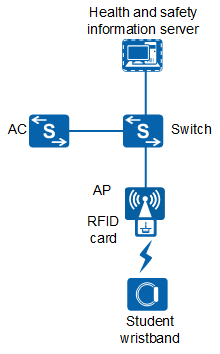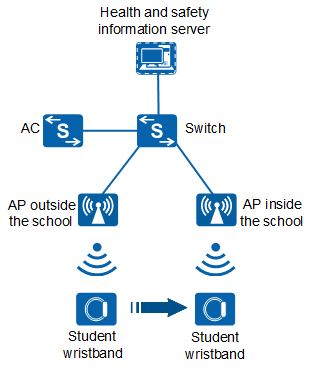Understanding the Education IoT Solution - Student Health and Safety
- Collects statistics on and monitors student health data and information such as the heart rate, pace, and duration of sleep, and sends the data and information to the health and safety information server. After being parsed by the server, the data and information is sent to the health platform. The health platform analyzes the collected health data, monitors students' health status, and provides health suggestions accordingly.
- Supports query for students' safety information. The time when students enter and leave schools can be recorded, so that schools and parents can check whether students enter and leave schools on schedule. Additionally, the information is also saved as attendance data
Student Health
Figure 1 shows how the student health management solution is implemented.
A student wristband collects and buffers health data of a student, such as the heart rate, pace, and duration of sleep.
When the amount of data buffered in the wristband reaches a specified threshold, the wristband sends the data to the RFID card in the AP through the 433 MHz radio module.
The RFID card buffers the received data. When the amount of data buffered in the RFID card reaches a specified threshold, the RFID card packages the data and sends it to the upper-layer server through the AP and upstream Ethernet links.

The server provided by Telpo can communicate with the RFID card using TCP.
The server parses the received data and sends the parsed data to the health platform in real time.
Student Safety
Figure 2 shows how the student safety management solution is implemented.
APs with built-in RFID cards are deployed inside and outside a school to cover areas inside and outside the school, respectively.
A student wristband inside the school sends its ID to the RFID card of the AP inside the school through the 2.4 GHz radio module. When the student wristband is outside the school, it sends its ID to the RFID card of the AP outside the school.
When the student wristband sends its ID to the RFID card of the AP outside the school first and then to that inside the school, the student is considered entering the school. Conversely, the student is considered leaving the school.
After receiving wristband information, the RFID card sends the information to the upper-layer server through the AP and upstream Ethernet links.
The server parses the wristband ID, RFID card ID, and information report time to obtain the time when the student enters or leaves the school.

The health and safety information server is configured as the host computer of the APs. The host computer in the following sections refers to the health and safety information server.

